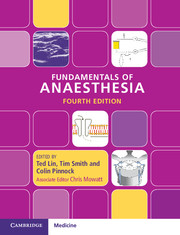Book contents
- Fundamentals of Anaesthesia
- Fundamentals of Anaesthesia
- Copyright page
- Dedication
- Contents
- Contributors
- Preface to the first edition
- Preface to the second edition
- Preface to the third edition
- Preface to the fourth edition
- Acknowledgements
- Abbreviations
- Section 1 Clinical anaesthesia
- Chapter 1 Preoperative management
- Chapter 2 Conduct of anaesthesia
- Chapter 3 Intraoperative management
- Chapter 4 Postoperative management
- Chapter 5 Special patient circumstances
- Chapter 6 The surgical insult
- Chapter 7 Regional anaesthesia
- Chapter 8 Principles of resuscitation
- Chapter 9 Major trauma
- Section 2 Physiology
- Section 3 Pharmacology
- Section 4 Physics and clinical measurement
- Index
- References
Chapter 2 - Conduct of anaesthesia
from Section 1 - Clinical anaesthesia
Published online by Cambridge University Press: 19 January 2017
- Fundamentals of Anaesthesia
- Fundamentals of Anaesthesia
- Copyright page
- Dedication
- Contents
- Contributors
- Preface to the first edition
- Preface to the second edition
- Preface to the third edition
- Preface to the fourth edition
- Acknowledgements
- Abbreviations
- Section 1 Clinical anaesthesia
- Chapter 1 Preoperative management
- Chapter 2 Conduct of anaesthesia
- Chapter 3 Intraoperative management
- Chapter 4 Postoperative management
- Chapter 5 Special patient circumstances
- Chapter 6 The surgical insult
- Chapter 7 Regional anaesthesia
- Chapter 8 Principles of resuscitation
- Chapter 9 Major trauma
- Section 2 Physiology
- Section 3 Pharmacology
- Section 4 Physics and clinical measurement
- Index
- References
Summary
The safe conduct of anaesthesia begins before the patient has arrived in the anaesthetic room. Consideration should be given to the methods of induction and maintenance of anaesthesia, airway management, positioning of the patient in theatre, necessary monitoring and the level of postoperative care required. It is important that all members of the anaesthetic and surgical team are fully informed of the planned procedure and its implications, including any foreseen difficulties that may arise.
- Type
- Chapter
- Information
- Fundamentals of Anaesthesia , pp. 29 - 45Publisher: Cambridge University PressPrint publication year: 2016



